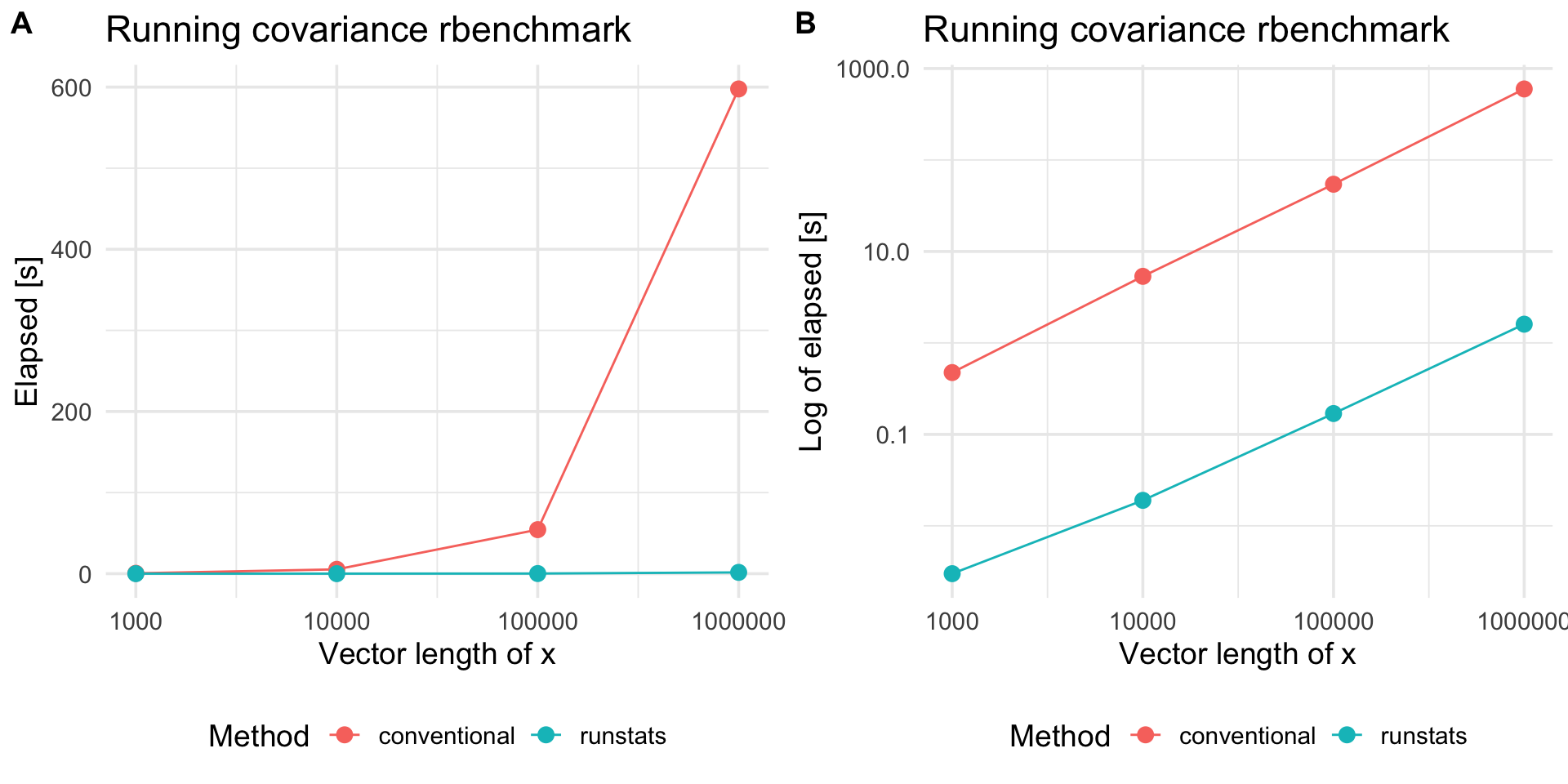The hardware and bandwidth for this mirror is donated by METANET, the Webhosting and Full Service-Cloud Provider.
If you wish to report a bug, or if you are interested in having us mirror your free-software or open-source project, please feel free to contact us at mirror[@]metanet.ch.
Package runstats provides methods for fast computation
of running sample statistics for time series. The methods utilize
Convolution Theorem to compute convolutions via Fast Fourier Transform
(FFT). Implemented running statistics include:
Package website is located here.
# devtools::install_github("martakarass/runstats")
install.packages("runstats")library(runstats)
## Example: running correlation
x0 <- sin(seq(0, 2 * pi * 5, length.out = 1000))
x <- x0 + rnorm(1000, sd = 0.1)
pattern <- x0[1:100]
out1 <- RunningCor(x, pattern)
out2 <- RunningCor(x, pattern, circular = TRUE)
## Example: running mean
x <- cumsum(rnorm(1000))
out1 <- RunningMean(x, W = 100)
out2 <- RunningMean(x, W = 100, circular = TRUE)To better explain the details of running statistics, package’s
function runstats.demo(func.name) allows to visualize how
the output of each running statistics method is generated. To run the
demo, use func.name being one of the methods’ names:
"RunningMean","RunningSd","RunningVar","RunningCov","RunningCor","RunningL2Norm".## Example: demo for running correlation method
runstats.demo("RunningCor")
## Example: demo for running mean method
runstats.demo("RunningMean")
We use rbenchmark to measure elapsed time of
RunningCov execution, for different lengths of time-series
x and fixed length of the shorter pattern
y.
library(rbenchmark)
set.seed (20181010)
x.N.seq <- 10^(3:7)
x.list <- lapply(x.N.seq, function(N) runif(N))
y <- runif(100)
## Benchmark execution time of RunningCov
out.df <- data.frame()
for (x.tmp in x.list){
out.df.tmp <- benchmark("runstats" = runstats::RunningCov(x.tmp, y),
replications = 10,
columns = c("test", "replications", "elapsed",
"relative", "user.self", "sys.self"))
out.df.tmp$x_length <- length(x.tmp)
out.df.tmp$pattern_length <- length(y)
out.df <- rbind(out.df, out.df.tmp)
}knitr::kable(out.df)| test | replications | elapsed | relative | user.self | sys.self | x_length | pattern_length |
|---|---|---|---|---|---|---|---|
| runstats | 10 | 0.005 | 1 | 0.004 | 0.001 | 1000 | 100 |
| runstats | 10 | 0.023 | 1 | 0.018 | 0.004 | 10000 | 100 |
| runstats | 10 | 0.194 | 1 | 0.158 | 0.037 | 100000 | 100 |
| runstats | 10 | 1.791 | 1 | 1.656 | 0.125 | 1000000 | 100 |
| runstats | 10 | 20.234 | 1 | 17.660 | 2.514 | 10000000 | 100 |
To compare RunStats performance with “conventional”
loop-based way of computing running covariance in R, we use
rbenchmark package to measure elapsed time of
RunStats::RunningCov and running covariance implemented
with sapply loop, for different lengths of time-series
x and fixed length of the shorter time-series
y.
## Conventional approach
RunningCov.sapply <- function(x, y){
l_x <- length(x)
l_y <- length(y)
sapply(1:(l_x - l_y + 1), function(i){
cov(x[i:(i+l_y-1)], y)
})
}
set.seed (20181010)
out.df2 <- data.frame()
for (x.tmp in x.list[c(1,2,3,4)]){
out.df.tmp <- benchmark("conventional" = RunningCov.sapply(x.tmp, y),
"runstats" = runstats::RunningCov(x.tmp, y),
replications = 10,
columns = c("test", "replications", "elapsed",
"relative", "user.self", "sys.self"))
out.df.tmp$x_length <- length(x.tmp)
out.df2 <- rbind(out.df2, out.df.tmp)
}Benchmark results
library(ggplot2)
plt1 <-
ggplot(out.df2, aes(x = x_length, y = elapsed, color = test)) +
geom_line() + geom_point(size = 3) + scale_x_log10() +
theme_minimal(base_size = 14) +
labs(x = "Vector length of x",
y = "Elapsed [s]", color = "Method",
title = "Running covariance rbenchmark") +
theme(legend.position = "bottom")
plt2 <-
plt1 +
scale_y_log10() +
labs(y = "Log of elapsed [s]")
cowplot::plot_grid(plt1, plt2, nrow = 1, labels = c('A', 'B'))
Platform information
sessioninfo::platform_info()
#> setting value
#> version R version 3.5.2 (2018-12-20)
#> os macOS Mojave 10.14.2
#> system x86_64, darwin15.6.0
#> ui X11
#> language (EN)
#> collate en_US.UTF-8
#> ctype en_US.UTF-8
#> tz America/New_York
#> date 2019-11-14These binaries (installable software) and packages are in development.
They may not be fully stable and should be used with caution. We make no claims about them.